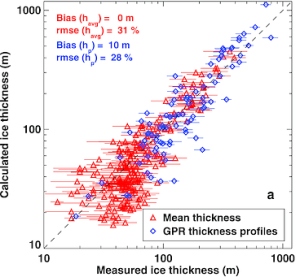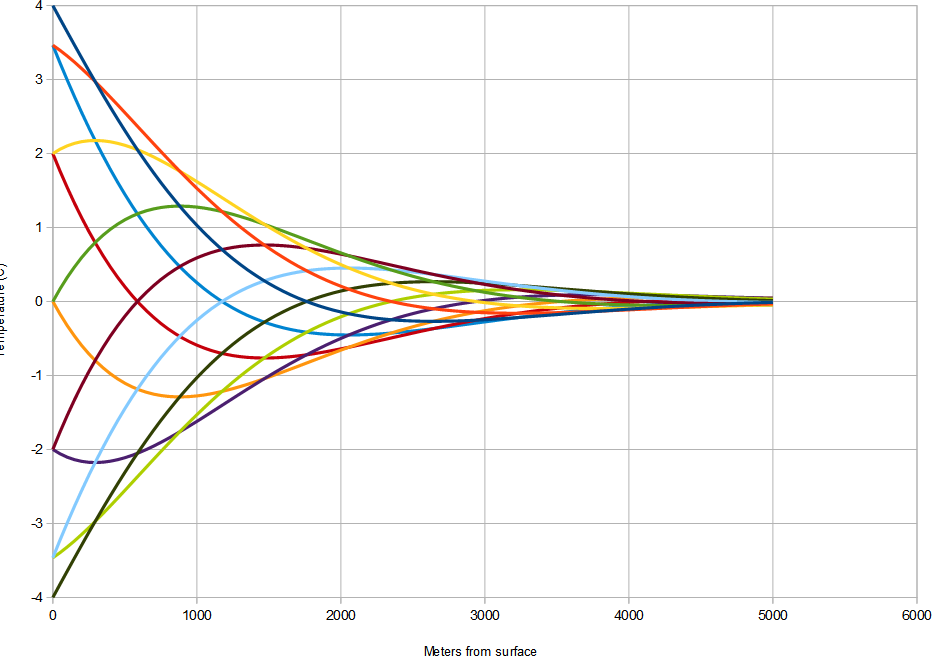For a while whenever someone mentions Arctic ice – and then I mention growing Greenland surface ice and they counter with the old chestnut “Bulk ice is melting” I then counter with the Haseler rebuke: “but surface ice tells us what is happening now, whilst bulk ice is a lagging indicator”.
So far this has totally flummoxed them as they have no idea what I’m talking about and the alarmists are all so stupid that they don’t dare show their stupidity by asking me to explain (which makes them totally dumb).
But whilst it means I win every argument – what has bugged me is that I never actually worked out how lagging it was. So today, prompted by Paul Homewood’s excellent article: “What The IPCC Said About Glaciers In 1990“, I’ve finally done some calculations. The simple answer is that the thermal diffusivity of ice is not that much different to rock – so my seat of the pants estimations were not that wrong. That means that day-to-day changes penetrate a few tens of centimetres, year-to-year a few meters and thermal changes over an ice-age cycle penetrate a few kms. (Hence the caterpillar theory of plate tectonics).
But first lets get the answer to the simple question:
How thick are glaciers
A good guess is that the ice thickness is about one-half of the surface width of the glacier. Although few glaciers have been measured, the measured thicknesses range from a few tens of meters for small glaciers to about 1,500 meters for the largest glaciers in Alaska. (source)
Antarctic ice is up to 4.7 kilometers (3 miles) thick in some areas. (source)
Looking for more information I found a paper as shown by the graph below:
 For details see: Distributed ice thickness and volume of all glaciers around the globe
For details see: Distributed ice thickness and volume of all glaciers around the globe
So Glaciers are between a few 10s of meters and a km thick and ice-sheets from a few meters at the edges to several km in the centre.
Thermal heating – not that easy to model
However, the way heat penetrates is hard to model. What I’d ideally like to do, is display a curve for a step change in temperature of the surface and show the resultant warming at various intervals. I tried finding that – but nothing turned up.
So instead I’m going to use a simpler approach and answer the question is “what happens to temperature change following a sinusoidal at the surface?”
100year Sinusoid
If the temperature were to vary as a sinusoidal with period 100years, The temperature at approx 25m deep would be 1/2 that of the surface. The temperature at 60m would be delayed by 25years.
1000year Sinusoid
Due to some oddities in the way heat penetrate objects… (don’t blame me it’s the physics)
If that sinusoidal were 1000years long, it would be 1/2 amplitude at ~80m and delayed by 250years at 190m deep.
10000year Sinusoid (ice-age cycle)
But if 10,000 years long, heat at around 250m would be responding to half the surface change and it would be delayed by 2500years at 600m deep.
Min-Max over 100year (estimated by 200year Sinusoid)
So in rough terms (ignoring water flow through the ice) the ice of a glacier about 100m deep is responding to temperature changes that were occurring around 50-100years ago.
100,000year Sinusoid (ice-age cycle)
But if we have a cycle 100,000 years long, the heat at around 750m would be responding to half the surface change and the temperature change would be delayed by 25000years at 1800m deep. That tells us the phase of the heating is delayed by 25000/1800 = 14years/m. Which suggests that any ice over around 700m thick may well be responding in temperature from the change coming out of the last glaciation (10,000 years ago). That would not affect many glaciers, but it does suggest that the thicker parts of the ice-sheets (>1km) are still WARMING UP FROM THE END OF THE ICE-AGE.
That tells us the phase of the heating is delayed by 25000/1800 = 14years/m. Which suggests that any ice over around 700m thick may well be responding in temperature from the change coming out of the last glaciation (10,000 years ago). That would not affect many glaciers, but it does suggest that the thicker parts of the ice-sheets (>1km) are still WARMING UP FROM THE END OF THE ICE-AGE.
So, next time some idiot starts telling me that Greenland ice sheet is losing bulk, that is the:
The aging ice sheet is only a few metres thick at the ice fringe, but more than 3,200 metres (10,500 feet) thick at its highest point. (source)
That idiot is going to get a few choice words from me about delays in thermal heating.

